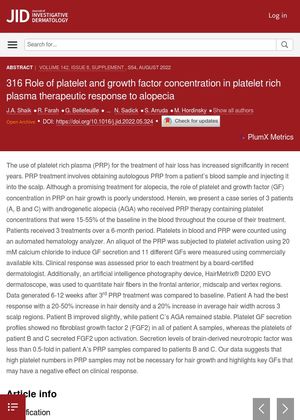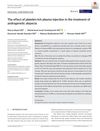Role of Platelet and Growth Factor Concentration in Platelet Rich Plasma Therapeutic Response to Alopecia
July 2022
in “
Journal of Investigative Dermatology
”

TLDR High platelet numbers in PRP may not be essential for hair growth, and certain growth factors could negatively affect treatment outcomes for hair loss.
The document presents a case series of 3 patients with androgenetic alopecia (AGA) who underwent platelet rich plasma (PRP) therapy, a treatment for hair loss. The PRP used contained platelet concentrations that were 15-55% of the baseline in the blood. The patients received 3 treatments over a 6-month period. The results showed that patient A had the best response with a 20-50% increase in hair density and a 20% increase in average hair width across 3 scalp regions. Patient B improved slightly, while patient C’s AGA remained stable. The study found no fibroblast growth factor 2 (FGF2) in all of patient A samples, whereas the platelets of patient B and C secreted FGF2 upon activation. The data suggests that high platelet numbers in PRP samples may not be necessary for hair growth and highlights key growth factors that may have a negative effect on clinical response.








